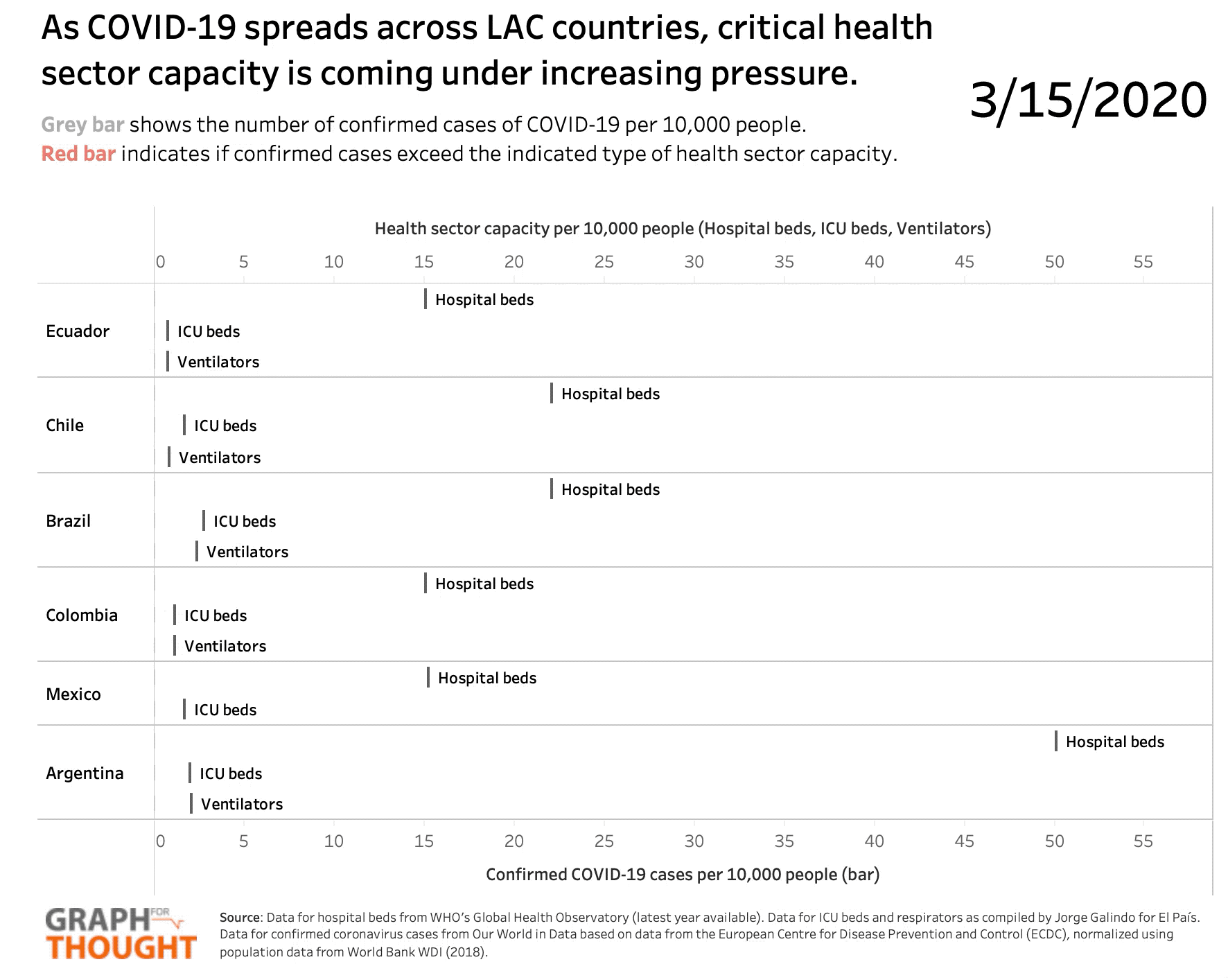Coronavirus as a Governance Challenge: Is LAC prepared to take on COVID-19? (Updated version)
March 18, 2020
On March 11, 2020 the World Health Organization declared COVID-19 (Coronavirus) to be a global pandemic. While the disease was slow to spread to LAC countries at first, since the end of February the number of confirmed cases has been climbing rapidly. As of August 24th, there were a total of 6,696,100 cases across the region. It is important that countries take swift action to prevent the spread of the disease and to protect their populations. As Vernon Lee, the director of the communicable diseases division at Singapore’s Ministry of Health remarked, we need “to stay one or two steps ahead of the virus...If you chase the virus, you will always be behind the curve.”
Critical in responding to this disease is the need to “flatten the curve” This means implementing protective measures to slow down the spread of the disease such that the number of cases does not overwhelm the capacity of the health care system all at once. This #GraphForThought takes a look at the current COVID-19 situation in LAC and assesses countries’ capacity to respond to the pandemic. LAC countries are shown in green and benchmark countries (China, Italy, Spain, and the USA) are shown in grey—to offer context for LAC’s situation. The graph uses the number of hospital beds per 10,000 people as a proxy for capacity in the health sector—as severe cases of COVID-19 require hospitalization. This is represented on the graph by the dot. The total number of confirmed COVID-19 cases in the country per 10,000 people is shown by the bar. Each bar is labeled with the total number of cases (not normalized). It is important to note, however, that the cases shown here are only those that have been confirmed by testing—and countries with higher health sector capacity are likely those that are testing more in the first place. We have no data on the number of undetected cases—and importantly, we can only respond to the cases we know. Indeed, the WHO is calling to “test, test, test.”
The graph shows us that that while some LAC countries have a relatively high stock of capacity, others may struggle greatly to meet a surge in demand for health services due to COVID-19. In particular, we see that countries such as Barbados, Cuba, and Argentina have a high capacity to respond. On the other hand, countries such as Honduras, Haiti, and Guatemala have a far lower capacity to respond. If countries such as Italy that have a relatively high level of capacity were overwhelmed by COVID-19 demands, these countries may face an even more difficult situation if prevention is not taken seriously. It is also important to note that these numbers show national level averages for health capacity—greatly obscuring inequalities within countries. For example, in rural areas, health capacity may be far lower than in urban areas. It is critical that we ensure that all countries receive the support they need to care for their entire population—leaving no one behind.
Moreover, it is important to remember that diseases do in fact discriminate—and the most vulnerable among us may be the most at-risk in this situation. Indeed, it is not only age that makes people more vulnerable—but also one’s socioeconomic situation. Not only are those in lower socioeconomic rungs more likely to have a chronic health condition (making COVID-19 more deadly), they may be less likely to have access to good healthcare and also less likely to be employed in a job that allows them to work remotely or take paid time off (making them more exposed to COVID-19). They are also the least likely to be able to weather an economic shock due to a sudden loss of income. As this article explains, this creates a self-reinforcing cycle between coronavirus and inequality. We must ensure that our social safety nets are strong and reaching those who need them the most right now. We must support our partner countries in building resilience at this challenging moment.
Update (May 6th, 2020): As COVID-19 has spread across LAC countries, their health systems have come under increasing pressure. As of May 2nd the number of confirmed COVID-19 cases (per 10k people) in Ecuador surpassed the number of hospital beds (per 10k people), and as of May 6th the same occurred in Peru. While not all COVID-19 cases require hospitalization and the cumulative number of cases does not reflect the current number of active cases—this is still a helpful indicator of the degree of pressure that the pandemic is putting on existing health sector capacity. While this post used the number of hospital beds as a proxy for existing health sector capacity (given the broader availability of the indicator across countries), even more relevant indicators in the context of COVID-19 are the number of Intensive Care Unit (ICU) beds and the number of ventilators. While this data is less readily available, this graph builds on a compilation of data from various sources by Jorge Galindo for a subset of six LAC countries, to provide a more detailed update. As the graph shows, as of May 3, the number of confirmed COVID-19 cases (per 10k people) had surpassed the number of ICU beds (per 10k people) and the number of respirators (per 10k people) in all but one (Argentina) of the six countries with available data. The red bar in the graph indicates where cases have surpassed capacity.


 Locations
Locations
